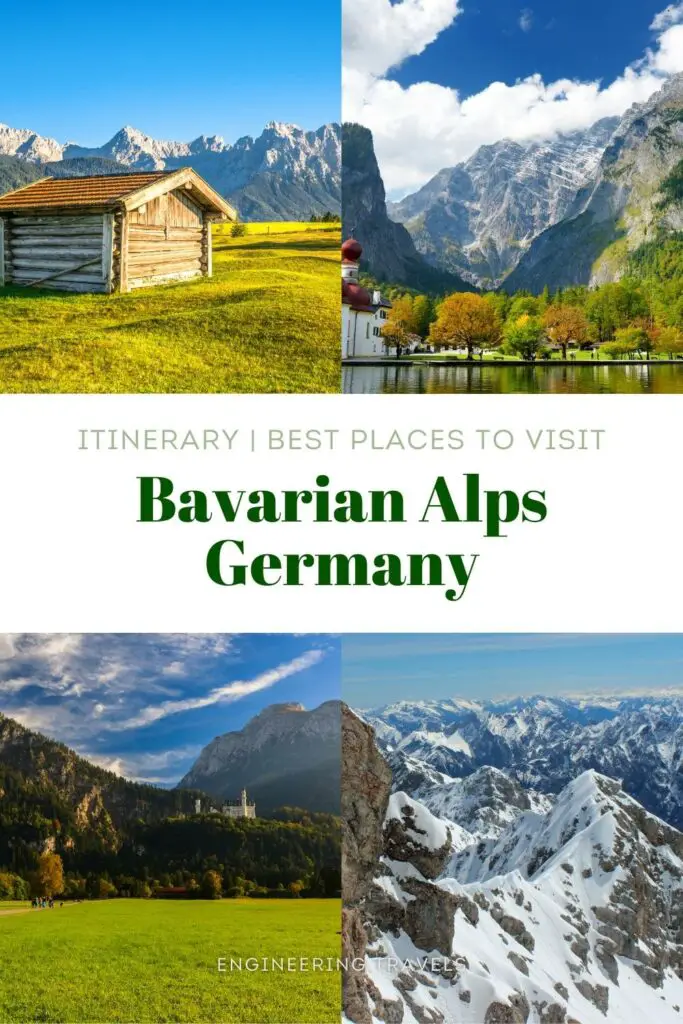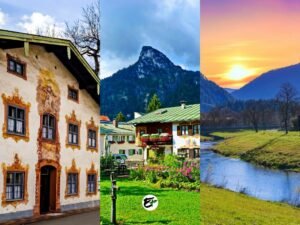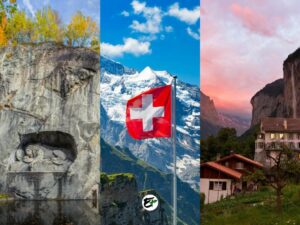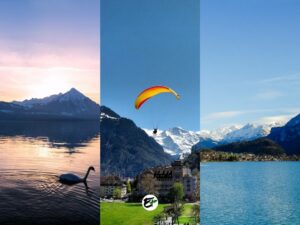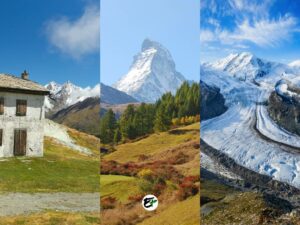20 Things to Do in Bavarian Alps: 5 Towns, 15 Attractions
Before, when I thought of Germany as a destination, my imagination would instantly turn to its beer festivals, cutting-edge car museums, and a wide range of historical attractions, from age-old medieval villages to significant World War II monuments.
It wasn’t until I discovered the Bavarian Alps, located in the southernmost part of Germany, that I realized Germany also boasts stunning natural landscapes. Despite the Bavarian Alps being just a small part of the country, I was surprised to find that it’s home to some of Germany’s most beautiful destinations — the places provide a unique blend of culture, adventure, and breathtaking scenery.
What’s more exciting? The Bavarian Alps are home to some of the country’s unique and iconic destinations. These include the enchanting Neuschwanstein Castle, Zugspitze – the highest peak in Germany, and Oberammergau, a village renowned for its Passion Play.
There are even more incredible destinations waiting for you in the Bavarian Alps, and the three mentioned are just the beginning. Allow me to introduce you to the most remarkable attractions and activities that this splendid region has to offer.
This post contains affiliate links. I may receive a tiny commission at no additional cost to you.
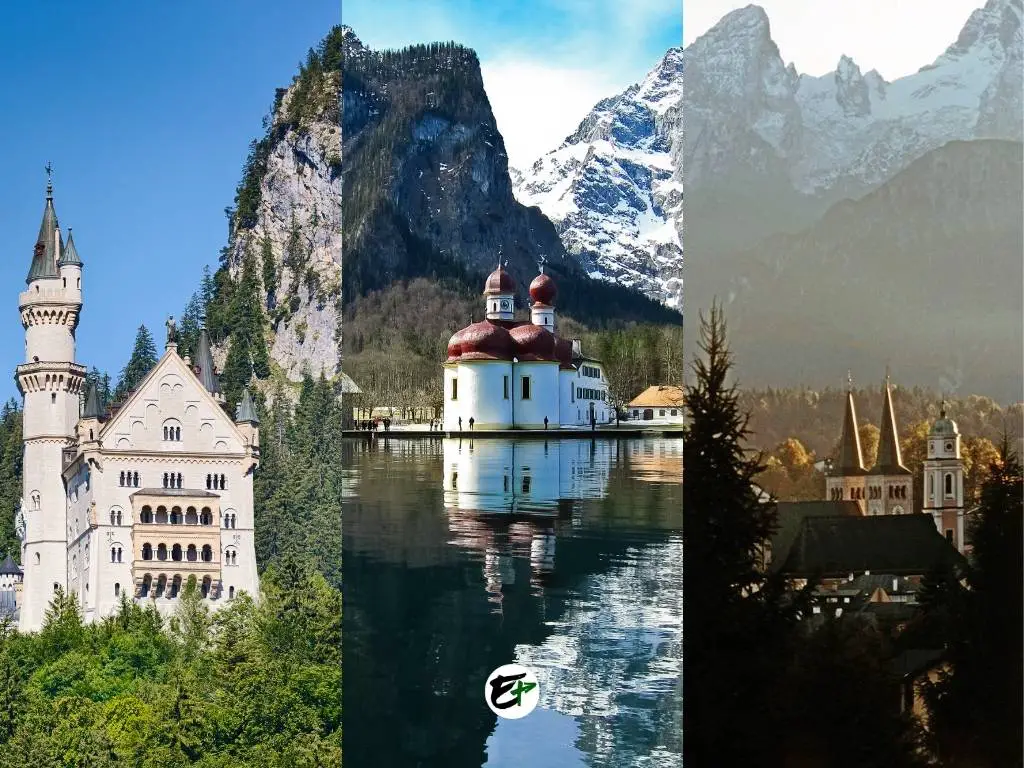
Use the table of contents to skip to topics.
Good to know: This post can also help you create your own Bavarian itinerary with the tips and travel information after the discussion about the destinations in Bavarian Alps.
- If you are in need of a pre-made Bavarian Alps itinerary, you can refer to my 3-day Bavarian Alps Itinerary. This is best suited for weekend trips.
- Alternatively, you might consider the 7-day Bavarian Alps Itinerary. This is a week-long trip that offers the region’s best experiences.
- Lastly, for the ultimate trip that includes all the highlights, you can check out the 10-day Bavarian Alps Itinerary.
To put it simply, the Alps in Germany are situated in the southernmost part of the country, stretching along the German-Austrian border from Lindau to Berchtesgaden, from west to east. The German Alps are entirely within the state of Bavaria, hence the name Bavarian Alps.
Scattered along the Bavarian Alps, you’ll find charming alpine towns and villages that are not only travel destinations but also bases for exploring nearby natural attractions and adventures. Five towns and villages caught my attention; from east to west, they are Berchtesgaden, Mittenwald, Garmisch-Partenkirchen, Oberammergau, and Hohenschwangau.
These locations provide quick access to the top attractions in the Bavarian Alps and memorable outdoor adventures like:
- Konigssee
- Eagle’s Nest
- Salt Mine
- Karwandel
- Leutasch Gorge
- Hummock Meadows
- Zugspitze
- Eibsee
- Olympia-Skistadion Sprungschanze (Olympic ski stadium ski jump)
- Ettal Abbey
- Linderhof Palace
- Alpine Coaster
- Neuschwanstein Castle
- Hohenschwangau Castle
- Alpsee
Essentially, they are the highlights of the Bavarian Alps and should be included in your travel plans.
Find the best hotel deals in Bavarian Alps here.
Berchtesgaden
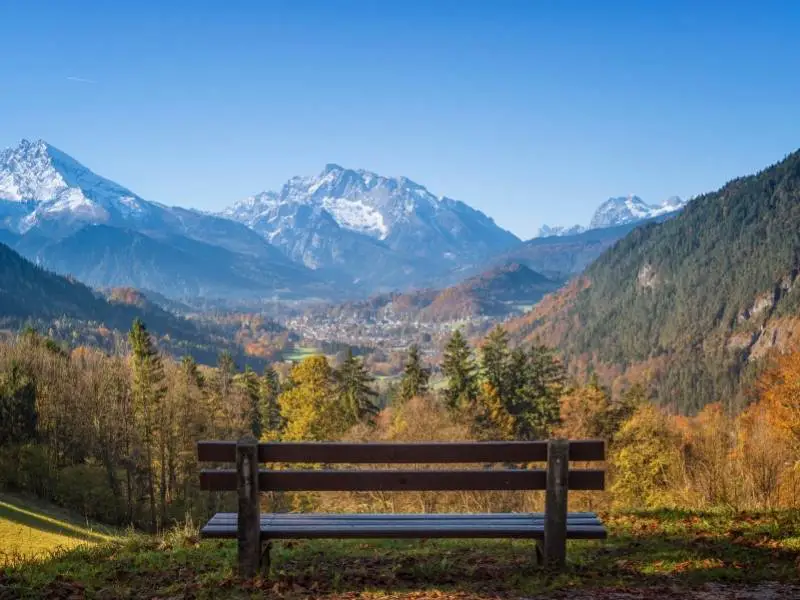
Fascinatingly, one of the most stunning locations to explore in all of Germany, is not in the heart of the country. Instead, it is situated in the country’s southeast corner: Berchtesgaden.
I often liken Berchtesgaden to Switzerland’s Lauterbrunnen or Jungfrau region, primarily due to the three peaks of the Watzmann Range, which remind me of Jungfrau, Monch, and Eiger. And if you’re an outdoor lover, Berchtesgaden is sure to give you a trip you will not forget! There’s a certain charm in extremes, as you’ll discover when we explore the highlights of a visit to Berchtesgaden.
Famed for its salt mine and the pristine Lake Konigs (Konigssee or King’s Lake), Berchtesgaden is a town that boasts a variety of natural wonders. This town serves as a gateway to Germany’s tallest waterfalls, the most charming chapel nestled by a lake, and a breathtaking WWII scenic landmark.
Situated in the extreme southeast of Germany, Berchtesgaden is nearly completely encircled by Austria. The town’s only connection to the rest of Germany extends northwest, towards Munich. In fact, Berchtesgaden is closer to the Austrian city of Salzburg than it is to Munich. Just a short 30-minute journey from Salzburg will bring you to Berchtesgaden.
If you plan to visit Berchtesgaden, the three things that you would not want to miss experiencing are:
- Cruising in Konigssee’s crystal clear lake water
- Seeing the epic view of the Bavarian Alps from Eagle’s Nest
- Viewing the spectacular tunnels in Salt Mine
You can cover Konigssee and Eagle’s Nest, the two main attractions in Berchtesgaden, in a single day tour. However, it’s advisable to set aside 2 to 3 days for your trip to Berchtesgaden, as the region boasts many more beautiful places to explore.
Berchtesgaden is brimming with numerous scenic spots waiting to be discovered, making it an ideal location for hiking. Given this, you might find yourself wanting to extend your stay to 4 to 5 days, or even up to a week.
Uncover all the details about Berchtesgaden in my article, which includes my personal reasons for considering Berchtesgaden as a must-visit destination or take a sneak peek at the scenic spots in Berchtesgaden.
Konigssee
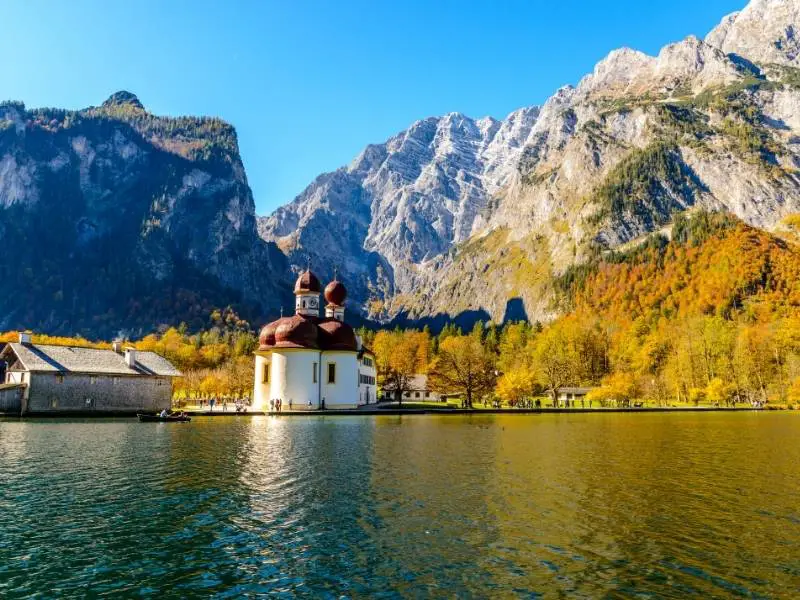
Konigssee, often referred to as the king’s lake, is widely regarded as Germany’s most stunning lake. Its beauty is undeniable, and it’s also one of the country’s cleanest bodies of water. The sight of Konigssee is something you could gaze at endlessly. The gentle waves, the shimmering, reflective surface, and its occasional misty demeanor will leave you in a state of pure bliss.
But that’s not all. You may have seen images on social media of a picturesque peninsula at Konigssee. This is where a charming pilgrimage church stands. The church of Saint Bartholomew is a sight that will captivate you more than you can imagine.
A trip to Konigssee also brings you within reach of three other stunning attractions in Berchtesgaden. These include the Ice Kapelle, Obersee, and the Röthbach waterfall, which holds the title of Germany’s tallest waterfall. So, a visit to Konigssee is not just about the lake, but an opportunity to explore these additional natural wonders.
Visiting information: koenigssee.de
Eagle’s Nest
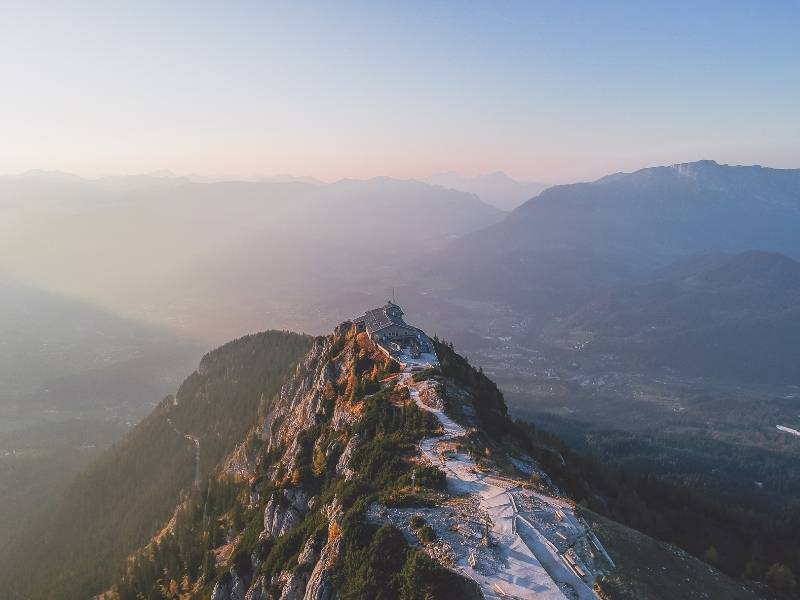
Berchtesgaden boasts several viewpoints, but none are as renowned as the Eagle’s Nest. This historic site was once a meeting place for the Nazis. The name “Eagle’s Nest” was coined during a rare diplomatic meeting with the French ambassador, André François-Poncet.
Perched on a ridge of the Hoher Goll mountain range, the Eagle’s Nest sits at an elevation of 1834 meters or 6017 feet. From this vantage point, you can witness the breathtaking transition of the Bavarian Alps into flatlands from south to north. On a clear day, you can easily spot Konigssee and Salzburg.
The Eagle’s Nest also houses a restaurant, offering a unique dining experience with a view. As you savor your meal, your eyes feast on the stunning panorama. To enrich your visit, historical tours are available. Participating in a tour is a great way to learn more about this fascinating location.
Visiting information: kehlsteinhaus.de
Salt Mine
Berchtesgaden offers unforgettable experiences, whether you’re on top of the mountains, drifting on the lake’s surface, or beneath the earth. If you’re looking for something unique on your journey in the Bavarian Alps, Berchtesgaden’s Salt Mine is worth a visit.
The tour inside the Salt Mine is a mix of fun activities, salt exhibitions, and experiences with technology used in extracting salt from the Alps. Laser shows, slides through tunnels, trains, and elevators provide insights into the 500-year-old Berchtesgaden salt mining culture. This activity would be great for kids, but for young adults like me, it might not be the best fit.
However, if you still have energy, you should focus on the absolutely scenic, breathtaking, and beautiful vantage points of the Bavarian Alps in Berchtesgaden. Some of these scenic spots in Berchtesgaden require a hike, but they are definitely worth it. If you visit Berchtesgaden during fantastic weather, your camera’s storage will fill up quickly.
Visiting information: salzbergwerk.de
Mittenwald

Do you love to wander aimlessly while traveling? If so, Mittenwald in the Bavarian Alps could be the perfect destination for you. Nestled close to the mountains and adorned with Lüftlmalerei throughout its town center, Mittenwald is sure to satisfy your desire for leisurely exploration.
Imagine strolling along a street lined with houses adorned with Lüftlmalerei, with the backdrop of snowy mountain peaks scraping the sky. It’s like walking through the pages of a fairytale! That’s the experience Mittenwald offers.
But where exactly is Mittenwald? It’s located in the heart of the Bavarian Alps, at the foot of the Karwendel mountain range. Its proximity to the German-Austrian border is such that a less than 30-minute hike can land you in Austria!
Mittenwald is also renowned for its violins. Centuries ago, people across Europe recognized Mittenwald as the source of high-quality violins. Today, you can delve into this centuries-old craft at the village’s Violin Making Museum, situated in the heart of the town.
You will love going to Mittenwald if these activities fit your liking:
- Dammkar Skiroute – Skiing in Germany’s longest
- Leutasch Gorge – Exploring a gorge with folklores
- Hummock Meadows – See mesmerizing, picturesque meadows
Wondering how long to stay in Mittenwald? If you’re planning to ski, take a short hike, explore the town, and visit Buckelwiesen and Leutasch Gorge, a 1 to 2-day stay is recommended. However, if you’re keen to visit the charming mountain huts and explore more of Karwendel by hiking, you might want to extend your stay.
Mittenwald also hosts events that you might want to experience, such as Mittenwalder Musiksommer and the Bringing in Sheep/Goats/Cattle in town. These unique local events could be worth scheduling your visit around.
Explore the different experiences and tourist attractions that await you in Mittenwald.
Dammkar Ski Route
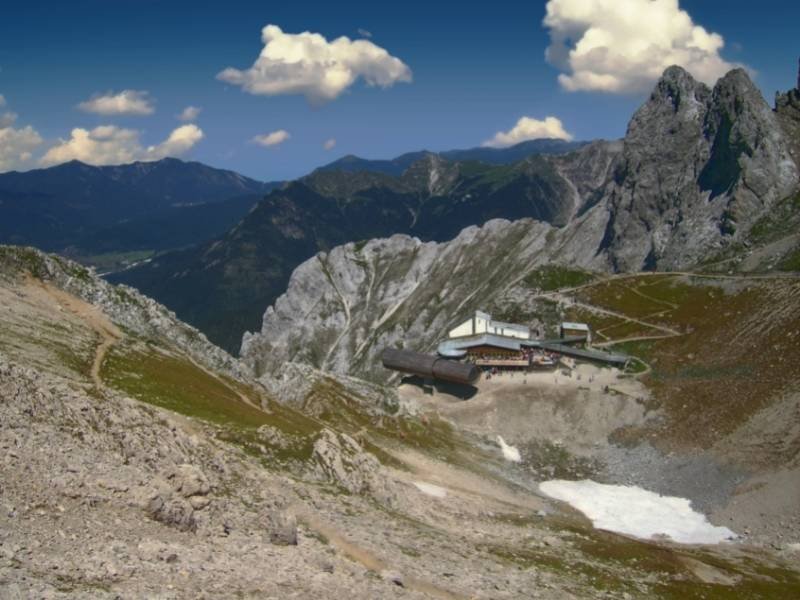
While Mittenwald may not boast views as grand as those in Berchtesgaden, it is home to the Dammkar Ski Route. This is one of Germany’s most exciting adventures and offers some of the best slopes in the Alps. It’s a dream come true for off-piste skiing enthusiasts.
The Dammkar Ski Route stretches over 7 kilometers, descending 1300 meters from Karwendel to Mittenwald. Along this route, you’ll encounter firm, powdery snow interspersed with slushy mogul fields. It’s the perfect playground for skiing aficionados!
Before you even begin your journey on the Dammkar Ski Route, there are exciting things to explore. The top station of the Karwendelbahn cable car, your gateway to Dammkar, is designed like a giant telescope overlooking the valley below. Adjacent to the top station, you’ll find an easy hiking trail offering views of the Northern Limestone Alps’ cirques.
Don’t forget to stop by the restaurant at the top station. Here, you can enjoy a meal or a beer on the sunny terrace, feasting your eyes on the stunning panorama as you satisfy your hunger.
Visiting information: karwendelbahn.de
Leutasch Gorge

Near Mittenwald, you’ll find another must-visit destination known for its record-breaking length. This is the Leutasch Gorge, the longest accessible gorge in the Eastern Limestone Alps.
The gorge is also referred to as the spirit gorge due to local myths that suggest it’s home to goblins and other supernatural beings. As you traverse the gorge, you’ll have the opportunity to face your fear of heights. This is thanks to the meshed steel pathways that offer views of the ground tens of meters below you.
These steel pathways, which are attached to the limestone walls of the gorge, lead you to the most breathtaking spots in the Leutasch Gorge. Here, you’ll encounter narrow rivers, views of the mountains nestled between giant rocks, and much more.
You will need at least two hours to visit every part of Leutasch gorge:
- Klammgeistweg – the place where you will learn the gorge’s myths, geology, and ecology.
- Koboldpfad – More exciting and trilling pathways
- Wasserfallsteig – The gem at the end of the gorge, a gorgeous waterfalls 23 meters high.
Visiting information: seefeld.com
Hummock Meadows
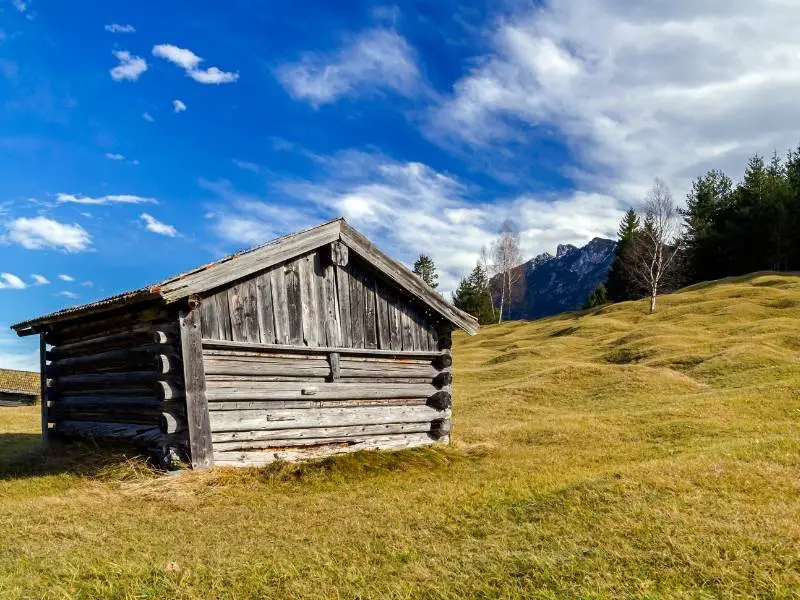
Mittenwald’s Hummock Meadows, or Buckelwiesen, is a unique and rare sight in the Bavarian Alps. This meadow is characterized by thousands of lumps and bumps, creating a whimsical, otherworldly landscape. The play of light and shadow during the golden hour, when the sun is at a low angle, accentuates these features, making them even more pronounced.
These meadows are scattered throughout Mittenwald. One can be found to the north of Lautersee, near a picturesque chapel, while another lies next to the Kranzberg Gipfel-Huette. While you can drive to these locations, exploring them on foot or by bicycle allows for a more intimate experience. As you travel, you’ll be treated to the charming scenery of the German countryside.
The Hummock Meadows are meticulously maintained and preserved by local farmers. Their efforts have not gone unnoticed – the Buckelwiesen has been recognized with awards in the past, including a diploma for conservation from the European Heritage Europa Nostra Awards.
Garmisch-Partenkirchen

Let’s turn our attention to Garmisch-Partenkirchen, the largest town in the Bavarian Alps. This town has some interesting history, having hosted the Winter Olympics in 1936 — an event that marked the unification of the towns of Garmisch and Partenkirchen under Adolf Hitler’s regime.
Today, Garmisch-Partenkirchen, often referred to as GaPa, is a premier destination in the Bavarian Alps. It offers a wide range of activities for visitors. Whether you’re looking for serene lakes, towering peaks, hiking trails, shopping opportunities, charming streets, or delicious Bavarian cuisine, GaPa has it all. It truly is the ultimate destination in the region.
That’s not to say other towns don’t have their own unique attractions. But in Garmisch-Partenkirchen, you’ll find numerous vantage points for breathtaking views. One such spot is Alpspix, an observation deck that juts out from a cliff near Alpspitze. From here, you can take in the stunning panorama of GaPa nestled in the valley, surrounded by mountains and verdant fields.
Among the towns nestled in the Bavarian Alps, Garmisch-Partenkirchen boasts the most diverse range of activities. My article about GaPa (link is found later) provides a thorough rundown of the attractions and activities available. Yet, if I had to choose, these would be my top three picks:
- Zugspitze
- Eibsee
- Olympia-Skistadion Ski Jump
Wondering how long to stay in Garmisch-Partenkirchen? Given the size of the town and the abundance of attractions, a stay of 2 to 3 days is generally recommended. This should give you ample time to explore all that the town has to offer.
However, if you’re planning to take advantage of the hiking trails, visit the picturesque lakes, explore the idyllic hamlets, and take in the stunning viewpoints around the town, you might find yourself wanting to extend your stay. Indeed, the beauty and charm of Garmisch-Partenkirchen could easily entice you to linger for much longer.
To truly appreciate Garmisch-Partenkirchen, make the most of your visit by exploring not just the top attractions around the village, but also its hidden gems. You can find more details about these lesser-known spots in my post titled ‘Why Garmisch-Partenkirchen is worth visiting.’
Zugspitze

Garmisch-Partenkirchen, or GaPa, serves as the gateway to Zugspitze, Germany’s tallest mountain. The peak of Zugspitze reaches an impressive 2,962 meters (9717 feet) above sea level.
Visitors flock to the top of Zugspitze for the vantage point, which offers panoramic views extending from Germany to Austria and Switzerland. On clear days, you can even see as far as the mountain ranges in northern Italy.
Like many other renowned peaks in the Alps, Zugspitze is serviced by a cable car. While this service comes at a cost, it saves you the effort of hiking to the summit. The cable car journey to the top of Zugspitze is an experience in itself, traversing the world’s highest steelwork pylon, which stands at 127 meters tall. It also boasts the world’s most significant overall height difference for a cable car, at 1945 meters. This journey will have you soaring skyward, more than twice the height of the world’s tallest building, in just a matter of minutes!
Once you reach the summit, the incredible views are not the only thing to enjoy. You’ll also find Germany’s highest beer garden, where you can savor the beauty of the mountains while satisfying your appetite.
Visiting information: zugspitze.de
Eibsee
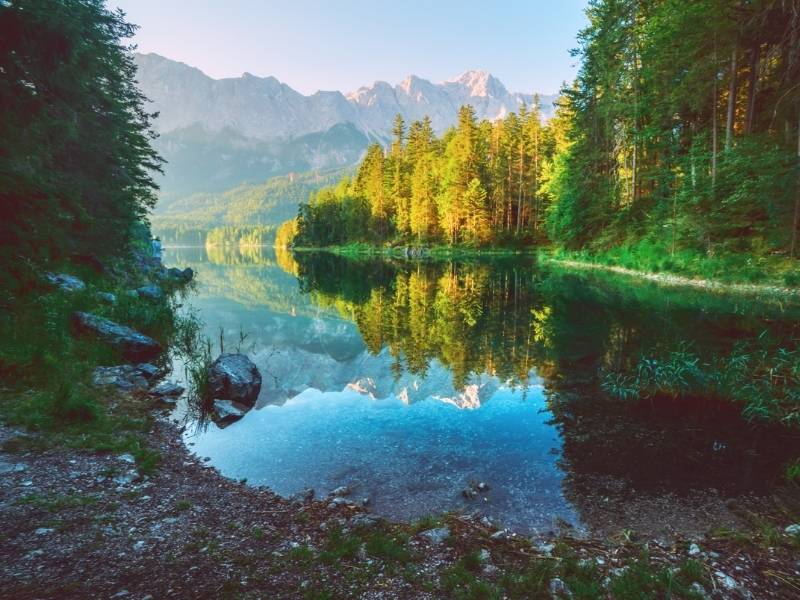
Near Eibsee, a lake located in Grainau, there’s a cable car station that will take you to the summit of Zugspitze. But before you embark on this journey, take some time to explore the lake.
Eibsee offers some of the best views of the Bavarian Alps, easily accessible from Garmisch-Partenkirchen. It’s a favorite among photographers. On calm days, when the surface of Eibsee is undisturbed, it serves as a giant mirror, reflecting Zugspitze and the surrounding peaks. This creates a stunning scene that is sure to garner likes on Instagram.
At times, Eibsee transforms into a magical lake, appearing misty and enchanting. Once the mist clears, you can rent kayaks and boats from nearby shops. Drift in the crystal clear water of Eibsee and visit the tiny islets scattered across the lake.
If you visit Eibsee during the less crowded season, you’ll find it incredibly peaceful. If you’re seeking a soothing retreat or a place to calm your mind, Eibsee is a “must include” in your Bavarian Alps itinerary.
Visiting Information: eibsee.de
Olympia-Skistadion Sprungschanze

While I may not be an Olympics enthusiast, the Olympia-Skistadion Sprungschanze in Garmisch-Partenkirchen is a reason to visit this town. It’s a unique attraction, and if you’re fortunate, you might even catch a glimpse of a ski-jumping athlete soaring through the air during your visit to GaPa!
I’ve never seen ski jump athletes in person, but watching videos of their performances on YouTube always leaves me in awe. The stadium is open to the public when there are no events taking place. If you’re interested in trying it out, you can register and request permission at the Garmisch-Partenkirchen tourism office.
In addition to the ski jump, Garmisch-Partenkirchen is also home to the Olympic Bobsleigh Run. This is where athletes once glided along curvy paths at speeds of up to 140 kph! However, it’s worth noting that the run is no longer open for public use as efforts are being made to preserve this historic landmark.
Visiting information: gapa-tourismus.de
Oberammergau
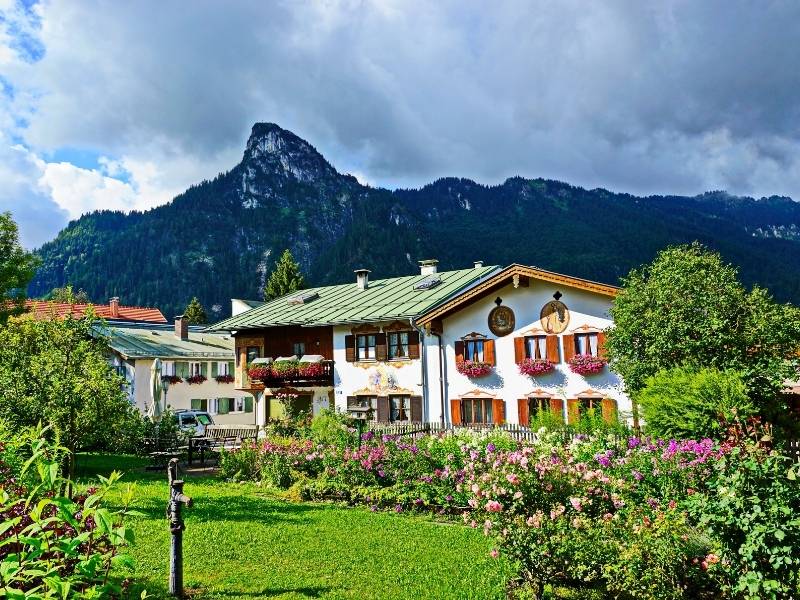
Oberammergau, nestled in the Bavarian Alps, offers a unique experience unlike any other town in the region. While it may not boast towering mountains, picturesque lakes, or fascinating gorges, it shines in its own right through its rich culture and tradition.
Known globally, particularly in the Christian West, Oberammergau is considered a must-visit destination in Germany due to its Passion Play. This event originated from a promise made by the villagers to God over 400 years ago. They vowed to perform the Passion Play every 10 years if they were spared from a plague. Miraculously, after making this promise, the villagers were indeed spared from the disease.
What’s truly inspiring is that the villagers of Oberammergau have remained steadfast in their commitment, even after centuries have passed. The Passion Play involves more than 2000 villagers participating in the re-enactment of the Passion of Christ. It’s a once-in-a-lifetime event that you’d be honored to witness.
But don’t worry if your visit to Oberammergau doesn’t coincide with the premiere of the Passion Play. The town is home to beautiful Lüftlmalerei and peaceful countryside vistas that are a feast for the eyes. Additionally, Oberammergau’s wood carving tradition is sure to fascinate you.
Even when the Passion Play isn’t taking place, Oberammergau has plenty to offer. Here are some attractions you can explore right away if you decide to stay in Oberammergau:
- Alpine Coaster
- Ettal Abbey
- Linderhof Palace
It’s worth noting that Ettal Abbey and Linderhof Palace make for excellent side trips from Garmisch-Partenkirchen. However, these attractions are much closer and more easily accessible from Oberammergau.
Let’s delve into each tourist attraction. But first, let’s address the question: how much time do you need in Oberammergau?
A single day in Oberammergau is sufficient to experience all the highlights of a visit to the village. In one day, you can explore the town, admire the beautiful Lüftlmalerei, watch the Passion Play (if it’s the 10th year), and enjoy the alpine coaster. If you plan to visit Ettal Abbey and Linderhof Palace, you’ll need to allocate an additional day.
To discover more about what the unique village of Oberammergau has to offer, I recommend reading my post, ‘Reasons to Visit Oberammergau.’
Oberammergau’s Alpine Coaster
While many believe that Oberammergau is only worth visiting during the premiere of its Passion Play, there’s a compelling reason to visit even during ordinary times. The world’s longest weatherproof toboggan run with magnetic brakes is located right here in Oberammergau!
This thrilling ride stretches over a length of 2600 meters, starting from a mountain near the town and covering a 400-meter altitude difference from the top. As you make your way down the track, you’ll experience 73 alpine coaster turns, 9 jumps, and 7 waves, all while speeding down the slopes at 40kph!
Oberammergau is full of surprises, and this fun-filled adventure is one of them. The experience is even more enjoyable during good weather, as the views from the alpine coaster are simply breathtaking.
Visiting information: kolbensattel.de
Ettal Abbey
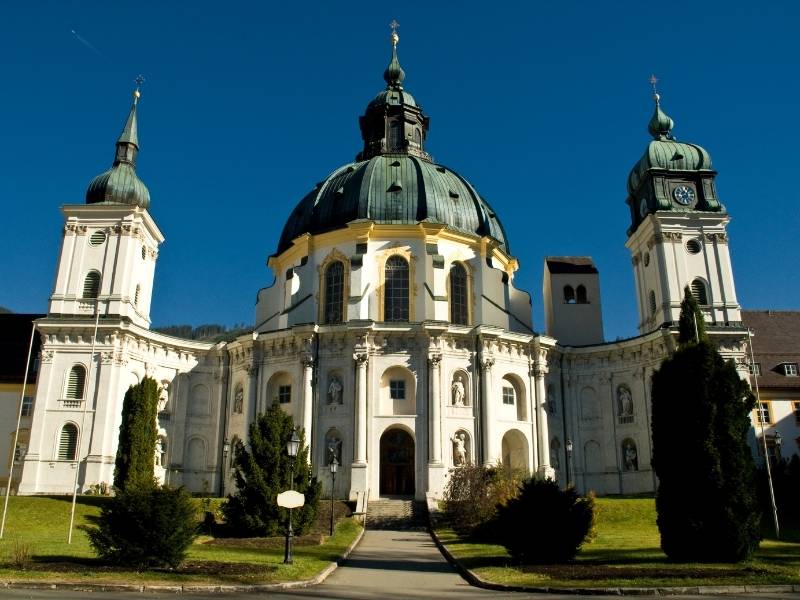
Ettal, a quaint village south of Oberammergau, is home to two architectural gems of the Bavarian Alps: Ettal Abbey and Linderhof Palace. Both attractions are just a short drive from Oberammergau, reachable within 20 minutes.
Ettal Abbey, the closer of the two, is a 14th-century Benedictine monastery that houses a brewery, hotel, and show dairy. The Abbey boasts an impressive dome adorned with mesmerizing frescoes. These captivating paintings could hold your gaze indefinitely! But be careful, you might end up with a stiff neck from looking up for too long. Just kidding!
Visiting information: klosterhotel-ettal.de
Linderhof Palace
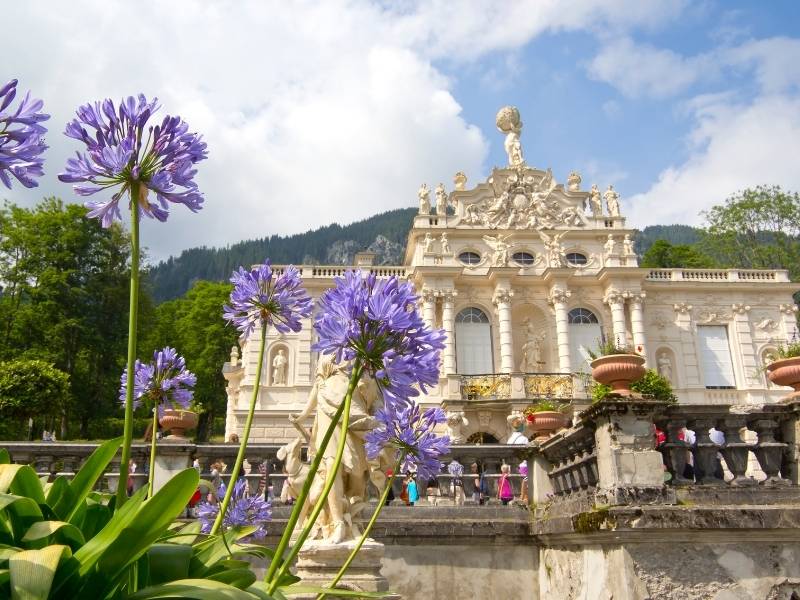
Linderhof Palace is nestled in the west of Ettal Abbey, a mere 15 to 20 minutes from Oberammergau. This palace is one of the three that King Ludwig II commissioned, and it stands out as the only one he lived to see finished. The interiors are a sight to behold, adorned with an impressive rococo design. Unfortunately, visitors are not permitted to capture this beauty in photographs.
The palace is complemented by a charming garden, which showcases a blend of architectural styles, including baroque and renaissance. As you wander through the garden, the ornate decorations, lush plants, and statues might make you feel like royalty enjoying a leisurely stroll.
While the main palace is compact, it is surrounded by other attractions that are equally pleasing to the eye. These additional features display a variety of cultures and architectural styles from diverse regions. The names of these attractions within Linderhof Palace give a hint of their inspirations.
- Venus Grotto
- Hunding’s Hut
- Gurnemanz Hermitage
- Moorish Kiosk
- Moroccan House
Visiting information: schlosslinderhof.de
Hohenschwangau
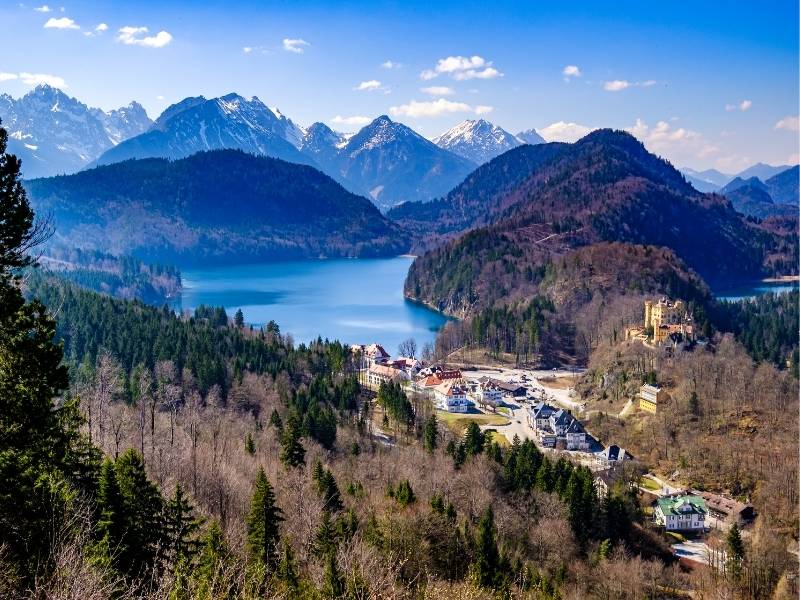
Hohenschwangau, the residence of King Ludwig II, is a must-visit destination nestled in the Bavarian Alps. Originally a small village within the Schwangau municipality, it transformed into a bustling urban district following the construction and subsequent popularity of Neuschwanstein Castle during the 19th and 20th centuries.
Today, Hohenschwangau welcomes approximately 2 million tourists and travelers each year. Its location on the northern edge of the Alps offers visitors breathtaking scenic views and the chance to explore fairytale-like castles perched atop the hills.
Here are the highlights of your visit to Hohenschwangau:
- Neuschwanstein Castle
- Hohenschwangau Castle
- Alpsee
Wondering how long to stay in Hohenschwangau? Typically, a single day in Hohenschwangau is sufficient. It’s even possible to do a day tour if you’re coming from nearby cities or towns, especially if your main focus is visiting the Neuschwanstein and Hohenschwangau castles.
However, to make the most of your visit, it’s advisable to visit the castles early in the morning or later in the afternoon. This strategy helps avoid the crowds and enhances the magical experience of the town.
For a deeper familiarity of Hohenschwangau, I invite you to read my detailed post on its crown jewel, Neuschwanstein Castle. This article not only delves into the castle itself but also explores nearby attractions such as Hohenschwangau Castle and Alpsee.
Neuschwanstein Castle

Neuschwanstein Castle is undeniably the primary attraction drawing millions to Hohenschwangau. This fairytale castle was the brainchild of the “fairytale king,” Ludwig II, who tragically passed away before witnessing the completion of his magnificent creation.
As quoted from discovery.com, “While Ludwig’s story doesn’t have a happy ending, his castles inspired a man known for crafting happy endings: Walt Disney. Sleeping Beauty’s Castle was inspired by Ludwig’s Neuschwanstein, as was Cinderella’s Castle.” It’s clear that Neuschwanstein Castle has not only inspired one individual but countless others.
Throughout the years, the castle has received numerous comments filled with awe and admiration. It’s easy to see why, given that it’s a real castle built by a real royal.
To truly appreciate the castle, you must join a 30-minute tour (tickets tend to sell out quickly during the summer). The real highlight, though, are the viewpoints of Neuschwanstein Castle. From here, you can fully appreciate the castle’s grandeur and its picturesque surroundings. It’s a once-in-a-lifetime experience, especially for those of us not native to Europe.
Visiting information: hohenschwangau.de
Hohenschwangau Castle

On the other side of the village, you’ll find Hohenschwangau Castle, which was once the home of King Ludwig II. This castle, perched on a small hill and painted yellow, can be spotted from the balcony of Neuschwanstein Castle.
Hohenschwangau Castle was originally built in the 12th century. However, it has been destroyed, reconstructed, and improved numerous times over the centuries. The final touches on the castle were made by King Maximillian II, the father of King Ludwig II.
While it may not be as grand as Neuschwanstein, the interiors of Hohenschwangau Castle are fascinating, adorned with paintings that weave together a series of stories. From the outside of this castle, your view of Neuschwanstein Castle may be obscured by trees. However, you’ll have a clear view of Lake Alpsee from the castle’s gardens.
Visiting information: hohenschwangau.de
Alpsee
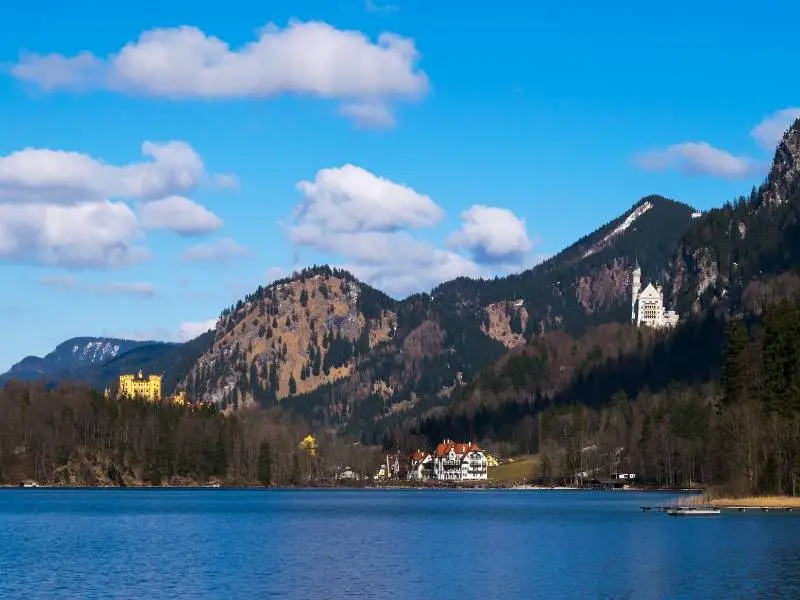
Alpsee is the ideal location if you wish to capture both Neuschwanstein and Hohenschwangau castles in a single frame. You have the option to rent a boat for the perfect vantage point or take a leisurely hike around the lake.
As you explore the area, you may come across charming wild swans gliding gracefully on the glittering water. The lake features a circular path for those who prefer a relaxed stroll. For the more adventurous, there are longer hiking trails available. Regardless of your choice, Alpsee promises a tranquil and soothing experience, offering a welcome respite from the bustling crowds.
Visiting Bavarian Alps: Plan Your Trip
Now that we’ve gone through the various towns and attractions in the Bavarian Alps, you should have a good idea of how to spend your time in this amazing region. Also, you’ve probably already decided which places you want to visit this time and which ones you’ll save for your next trip.
To help you plan your journey, I’ll provide you with some tables that show the distances between each town in the Bavarian Alps. Specifically, they are:
- Road distance and travel duration between towns in the Bavarian Alps
- Commute information and travel duration between towns in the Bavarian Alps
I’ll also provide information about:
- Road distance and travel duration from cities with airports to towns in Bavarian Alps
- Commuting information and travel duration from cities with airports to towns in Bavarian Alps
Read to read the purpose of the tables and some disclaimers.
The tables I’ll show you provide the following information: road distance, travel duration using a car, commuting complexity, and travel duration using public transportation.
- The “road distance” data in the tables I’ll provide can help you estimate costs for mileage, fuel, or car rental, should you choose to drive or hire a vehicle.
- The “travel duration using a car” information can assist you in managing your time efficiently, allowing you to plan when to depart from one location to arrive on time at your next destination.
- The tables also indicate the “commuting complexity,” which shows how many transfers are required to reach the next destination. Locations requiring multiple transfers often become a lower priority to avoid the hassle of purchasing multiple tickets and potentially incurring additional expenses, unless you opt for unlimited public transit passes.
- Lastly, the tables provide an estimate of the “travel duration using public transportation.” This is particularly useful if you plan to use public transport and have tours or bookings at specific times. By allowing ample time for your commute and coordinating it with your tour bookings, you can avoid the stress of missing your schedule.
Notes:
- The data from the tables are from Rome2Rio and Google Maps Schedule Explorer.
- Before you use the data to plan your itinerary, it’s important to consider the traffic situation at the time of your travel, especially if you’ll be traveling by car.
- The travel duration using public transportation, as shown in the tables, includes the time between transfers. These are the fastest estimates and are intended to give you an idea of how long you’ll be in transit.
- If you’re using public transportation, consider downloading the DB Navigator app for your Android or iPhone. This app provides train and bus journey information, helps you find the cheapest tickets, enables quick booking, and provides exact transit schedules.
Road Distance and Travel Duration Between Bavarian Alps Towns
From the information in the tables below, you can gauge the distance you’ll need to drive to reach your next stop and the duration of your journey.
| From/To | Berchtesgaden | Mittenwald | GaPa | Oberammergau | Hohenschwangau |
|---|---|---|---|---|---|
| Berchtesgaden | – | 188.7 km (2h 25m) |
188.4 km (2h 12m) |
189.6 km (2h 15m) |
216.6 km (2h 47m) |
| Mittenwald |
188.7 km (2h 25m) |
– |
17.9 km (16m) |
35.5 km (34m) |
78.7 km (1h 8m) |
| GaPa |
188.4 km (2h 12m) |
17.9 km (16m) |
– | 19.2 km (20m) |
61.6 km (52m) |
| Oberammergau |
189.6 km (2h 15m) |
35.5 km (34m) |
19.2 km (20m) |
– | 46 km (43m) |
| Hohenschwangau |
216.6 km (2h 47m) |
78.7 km (1h 8m) |
61.6 km (52m) |
46 km (43m) |
– |
Commute and Travel Time between towns in the Bavarian Alps
The tables below provide a clear picture of your commute. They show the number of transfers you’ll need to make, as well as the number of train or bus rides you’ll take. For instance, if you have 3 train rides, that means you’ll make 2 transfers. They also give an estimate of the total time you’ll spend commuting.
| From/To | Berchtesgaden | Mittenwald | GaPa | Oberammergau | Hohenschwangau |
|---|---|---|---|---|---|
| Berchtesgaden | – |
2 trains, 1 bus (4h 33m) |
2 trains, 1 bus (4h 9m) |
3 trains, 1 bus (5h 4m) |
3 trains, 1 bus (6h 7m) |
| Mittenwald |
2 trains, 1 bus (4h 38m) |
– |
1 bus (21m) |
2 trains (1h 43m) |
2 buses (3h 26m) |
| GaPa |
2 trains, 1 bus (4h 4m) |
1 bus (21m) |
– |
2 trains (1h 12m) |
1 bus (2h 6m) |
| Oberammergau |
3 trains, 1 bus (4h 59m) |
2 trains (1h 45m) |
2 trains (1h 16m) |
– |
1 bus (1h 30m) |
| Hohenschwangau |
3 trains, 1 bus (6h 7m) |
1 bus, 1 train (2h 43m) |
1 bus (2h 7m) |
1 bus (1h 31m) |
– |
How do I get to Bavarian Alps?
Now, let’s discuss how you can reach any of the towns in the Bavarian Alps.
There are many routes to the Bavarian Alps. You can start from anywhere in Germany or even from nearby countries. Thanks to technology, traveling from one place to another in Western Europe has never been easier. As long as you know how to use basic travel smartphone applications, you will never be lost.
You can download the most essential apps for traveling in Germany and the Bavarian Alps from the provided link.
- DB Navigator [ AppStore | PlayStore ] – For booking public transportation, finding schedules, real-time information, coach sequence, cheap deals, and so much more!
- Google Maps [ AppStore | PlayStore ] – For navigating with your car, finding the best route, and searching for train/bus schedules.
Google Maps alone is sufficient for our navigation, even using public transportation.
With the current tech we have now, regardless of whether you want to drive or use the trains, you no longer have to memorize streets, stations, and so much more just to get to the place you want to visit.
This is why I will no longer give you the exact steps of which street to turn to, which train line to ride on, and so on. Instead, I will provide more tables showing you how far the Bavarian Alps are from where you plan to start your journey. Using the tables:
- You can assess which destination in the Bavarian Alps is nearest to where you are coming from.
- If you’re coming from overseas, you can select which airport you would want to use for arrival in Germany or Europe, considering the Bavarian Alps as your primary destination.
- You can get an idea of which city to visit next after touring the Bavarian Alps.
- In some cases, you will also know which city you can use as your home base.
Cities and Airports Near Bavarian Alps
Here is the list of cities with airports near the Bavarian Alps that we can select for your arrival. These cities are in on this list because:
- You can reach the Bavarian Alps in less than 4 hours of driving from these cities. We don’t want to drive for more than half a day!
- You can use a public transport route from these cities to get to the Bavarian Alps in a shorter duration than taking another flight to a nearer city. In other words, land travel to the Bavarian Alps from these cities takes less time than air travel. Please note that the air travel time estimate includes the actual flight time, time spent during check-in, and time spent during the security check.
Driving Distance (Cities/Airports to towns in Bavarian Alps)
| Airport/City | Berchtesgaden | Mittenwald | GaPa | Oberammergau | Hohenschwangau |
|---|---|---|---|---|---|
| Frankfurt | TOO FAR | TOO FAR | TOO FAR | TOO FAR | 425.8 km (3h 30m) |
| Munich | 154.7 km (1h 31m) |
106.3 km (1h 16m) |
90 km (1h 2m) |
91.2 km (1h 4m) |
121.2 km (1h 36m) |
| Zurich | TOO FAR | 292.6 km (3h 15m) |
288.1 km (3h 9m) |
272.4 km (3h 6m) |
238.6 km (2h 31m) |
| Salzburg | 23.4 km (25m) |
182.4 km (2h 14m) |
182.1 km (2h 2m) |
183.2 km (2h 4m) |
210.3 km (2h 36m) |
| Innsbruck | 195.8 km (2h 2m) |
38.1 km (31m) |
55.7 km (46m) |
73.3 km (1h 4m) |
110.7 km (1h 22m) |
Commuting Distance (Cities/Airports to towns in Bavarian Alps)
| Airport | Berchtesgaden | Mittenwald | GaPa | Oberammergau | Hohenschwangau |
|---|---|---|---|---|---|
| Frankfurt | TOO FAR | 1 train (5h 41m) |
1 train (4h 46m) |
2 trains (5h 14m) |
3 trains + 1 bus (5h 43 m) |
| Munich | 1 train (2h 54m) |
1 bus (1h 40m) |
1 bus (1h 15m) |
2 trains (1h 50m) |
1 train + 1 bus (2h 33m) |
| Zurich | TOO FAR | 2 trains (5h 12m) |
2 trains (5h 50m) |
TOO FAR | 2 trains + 1 bus (5h 23m) |
| Salzburg | 1 bus (46m) |
2 trains (3h 27m) |
2 trains (3h 6m) |
3 trains (3h 34m) |
2 trains + 1 bus (4h 54m) |
| Innsbruck | 3 trains (3h 23m) |
1 bus (45m) |
1 bus (1h 10m) |
2 buses (2h 39m) |
3 buses (3h 40m) |
Here is an example of how the table can assist you.
Let’s say you found two flights to Germany. One is going to Frankfurt, and another is heading to Munich. The flights to Frankfurt are on sale and therefore cheaper, while the flights to Munich are at regular prices. You should choose the cheaper flight, right? Not so fast. You must also consider the land travel between Frankfurt and your destination in the Bavarian Alps. Now we choose:
- Should I take the cheaper flight but spend more hours on the road? This would mean more expenses for fuel or a train ride.
- Or should I take the flights to Munich? Here, we don’t care if it’s more expensive as long as I get to the Bavarian Alps in no time.
Public Transportation or Private Car?
Now that you know the attractions and towns to visit in the Bavarian Alps and the cities close to the Bavarian Alps where you can start your trip, the next question is: What’s the best mode of transport in the Bavarian Alps – train, bus, or private car?
Public transportation in the Bavarian Alps is generally efficient and convenient. There’s no real need to rent a car, particularly if you’re just going to the main attractions. A private vehicle might only be necessary if you need to get to a remote location quickly or if you want more freedom during your trip.
Best Time to Visit Bavarian Alps
Before you book your plane or train to the Bavarian Alps, make sure you are coming at the right time! Well, it’s actually hard to say when you should visit the Bavarian Alps because it’ll all depend on what kind of activities you want to experience.
But as a rule of thumb, if you want to see all the highlights of the Bavarian Alps, including the towns and the tourist attractions around Garmisch-Partenkirchen, Mittenwald, Oberammergau, Berchtesgaden, and Hohenschwangau, the best time to visit the Bavarian Alps is during the summer.
Summer is the time of the year when most tourist attractions are open to travelers, it’s not so chilly to do outdoor adventures, and different cultural festivals are taking place. It’s time to fully experience the Bavarian Alps!
However, because everyone is coming to the Bavarian Alps during this time, you must expect longer lines at the top tourist attractions, especially at Neuschwanstein Castle! The parking could be terrible, too, during this season so be prepared if you plan to travel by car.
Another nice thing about summer is that the length of the day is longer, giving you more opportunity to have more experiences to try and places to explore per day. Like, at the peak of the summer, the sun is up in the sky until 9:00 pm. I have to admit, as someone from the equator, I was amazed to see the sun set that late!
If you want a quieter visit to the Bavarian Alps and you want to see the mountains and lake at their most spectacular appearance, try visiting the Bavarian Alps during the Autumn (late September). Especially, Konigssee and Eibsee, during autumn, they’re the places where you can spend half a day boating or hiking, taking pictures with the stunning fall foliage trees reflected on the surface of the lake.
How Many Days in Bavarian Alps
So, you’ve decided to visit the Bavarian Alps? That’s fantastic! Now, you might be wondering how many days you would need to fully enjoy the Bavarian Alps.
If you want to see everything from Neuschwanstein to Berchtesgaden — essentially, the entire Bavarian Alps — you’ll need about 10 days. If you’re looking for a more leisurely pace and want to engage in more outdoor activities, you might want to extend your trip to two weeks or 14 days.
However, if you’re pressed for time, a week would be sufficient, although you might not be able to see every highlight of the Bavarian Alps. Here’s a suggestion for a 7-day itinerary: start in Munich and take a day trip to Neuschwanstein Castle. Then, move on to Garmisch-Partenkirchen or Mittenwald and spend 4 days exploring the towns and surrounding areas. Be sure to visit Zugspitze, Eibsee, and Linderhof Palace.
From your base in Garmisch-Partenkirchen, consider a day trip to Oberammergau and visit Ettal Abbey to add a cultural element to your trip. That brings us to six days. On the last day of your trip, you could go shopping for souvenirs or relax at a spa or take a scenic drive around the area.
Even if you’re only planning a weekend trip or a 3-day stay, you can still enjoy the Bavarian Alps. A quick trip to Berchtesgaden offers various attractions that provide a well-rounded experience of the Bavarian Alps in just a few days. Within three days in Berchtesgaden, you can visit Konigssee, Jenner, Rothbach Waterfall, Eagle’s Nest, and Salt Mine, and still have a few hours left for relaxation and culinary adventures.
So, after all that, the simple answer to the question ‘how many days in the Bavarian Alps’ is: it can range from 3 days to 14 days, depending on your preferences. The minimum is 3 days to truly enjoy and feel that you’ve seen the best of the Bavarian Alps.
Here’s where you can find the best hotel deals in Bavarian Alps.
Where to Go Next After Bavarian Alps
The Bavarian Alps in Germany can already provide a satisfying trip for those bitten by the travel bug. However, if it’s your first time in Germany, you might want to consider adding other destinations to your itinerary to make your trip even more worthwhile. As I mentioned earlier, there’s so much to see, from fairytale-like medieval villages to some of the coolest car museums in Europe.
The best part is that you don’t have to leave Southern Germany to experience some of the top attractions in the country. These destinations are easily accessible, even if you’re traveling using public transportation. Take Munich, for example. In just an hour or two, you can reach this wonderful city from any town in the Bavarian Alps, especially if you have a car.
From Munich, you can practically travel anywhere in Southern Germany, even without a car. Munich is just a train ride away from Wurzburg, Bamberg, Nuremberg, Stuttgart, and more. From these cities, you can reach even more amazing destinations with just another train ride. These include the Black Forest, Lichtenstein Castle, and Rothenburg ob der Tauber. You see, there are many!
These places I’ve mentioned are some of the must-see locations in Southern Germany. They offer some of the most unique and amazing experiences in the country.
Bavarian Alps vs Other Similar Destinations
If you love having more mountain adventures in Europe, there are more places you can visit after the Bavarian Alps. My top picks are in Italy, France, and of course, Switzerland.
In Italy, consider visiting Cortina d’Ampezzo. This town is at the heart of the spectacular Italian Dolomites, where some of the most stunning rock formations and crystal-clear mirror-like lakes can be found.
In France, check out Chamonix. This town is at the foot of the highest peak in all of the Alps — Mont Blanc. The town has a lot to offer, from mountain top festivals to an alpine animal park and walking inside a glacier.
In Switzerland, there are plenty of places you can visit. Switzerland has many beautiful villages and amazing cities near the Alps. However, my top picks are Interlaken, the adventure capital, and Zermatt, the place with the best views of the Matterhorn.
Save it on Pinterest.

